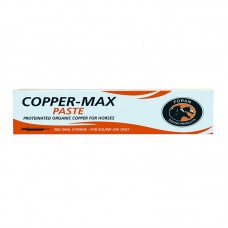Copper is one of the most important trace elements in the horse. It is a critical element in many important metabolic pathways in horses.
Copper (Cu) belongs to a group of elements known as trace elements, that is they are present and required in the body in very small amounts. Despite this, they are essential to the health and bodily functions of the animal and deficiency in intake and utilisation can have many deleterious consequences.
Concentrations of trace elements at the sites of activity in the body must be maintained within narrow limits. Animals possess mechanisms which regulate these concentrations and which can also store excess amounts in a non toxic form or eliminate them if necessary. This varies with species and element.
Most trace elements act as catalysts in chemical enzyme systems. Examples are copper and lysyl oxidase, iodine and thyroxine, chromium and insulin. Interactions between trace elements can occur so that balance between these in the diet is essential for health. Examples are copper, molybdenum and sulphur, copper, zinc and iron.
Copper is one of the most important trace elements in the horse. Others are zinc, iron, iodine, manganese and selenium. Copper is a critical element in many important metabolic pathways in horses. Copper is necessary in bone formation, elastin formation, haematopoesis, pigment formation, reproduction and immune system function.
Copper and the cardiovascular system
The two copper dependent enzymes, lysyl and amine oxidase, are concerned in elastin formation which substance gives blood vessels their elasticity. Where this system is deficient spontaneous rupture of large arteries can occur.
Copper and bone formation
Collagen is a primary material in the process of bone formation. The two copper dependent enzymes listed above are required to establish the cross linkages between the polypeptide chains which are the building blocks of collagen. Malfunction of this system leads to the production of poor quality collagen and later resulting orthopaedic problems. Copper may also be essential to the later mineralisation of bone.
Copper and red blood cells
In most species prolonged deficiency of copper results in anaemia. Iron is essential for the formation of red blood cells and haemoglobin. The copper containing enzyme of ceruloplasmin , ferroxidase, is essential for the mobilisation of iron from body stores in the liver, spleen and bone marrow and for the saturation of transferin, the iron transport system.
Copper in pigmentation and keratinisation
One of the first signs of copper deficiency is a lack of pigment in hair and a poor quality coat. One of the first results of copper supplementation in that situation is a marked improvement in coat colour and in the coat generally. A copper containing enzyme polyphenyl oxidase, facilitates the conversion of tyrosine to melanin, the hair and skin pigment. Copper is also concerned with the formation of keratin in hair, and hoof horn.
Copper and fertility
In other species than the horse presently studied, rats, cattle and sheep, copper deficiency resulted in foetal death and resorption, delayed oestrus and abortion.
How copper deficiency occurs
- Insufficient intake
- Low soil, herbage and ration Copper values
- Interaction with other elements
a. At root level in pasture—Zinc and Iron
b. In the animal—Zinc, Iron, Cadmium, Molybdenum and Sulphur
Copper requirement in horses
The daily requirement for copper in horses is 25-30 mg/kg of dry matter intake. Supplementation is ideally carried out on a routine daily basis. Where this is not possible e.g., horses at pasture, supplementation may take the form of a dose of a paste formulation two-three times a week.
Toxicity in horses is extremely rare. Horses do not accumulate copper in the liver as do cattle but more importantly sheep. In USA based trials, ponies were fed up to 1200 mg copper per day for long periods without toxicity.

